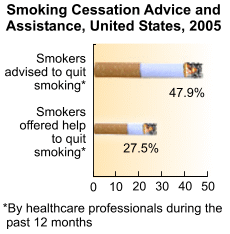Data & Statistics
Other Features
Featured Data & Statistics

Smoking Cessation Advice and Assistance
The Partnership for Prevention has analyzed data from the Behavioral Risk Factor Surveillance System (BRFSS)* and other CDC sources. Recently, the Partnership, which is sponsored by the CDC, The Robert Wood Johnson Foundation, and WellPoint Foundation, issued a report entitled Preventative Care: A National Profile on Use, Disparities, and Health Benefits. Its key finding is that cost effective preventive services have very low rates of use, although they have been recommended for years. BRFSS data highlighted in the report shows a large difference between the percentage of smokers advised to quit and those additionally offered help.
In 2005, 47.9 percent of smokers reported that healthcare professionals advised them to quit smoking in the past twelve months.1 In contrast, only 27.5 percent reported that healthcare professionals offered them help to quit during the same timeframe.1 This help can include medication assistance or other strategies.
To be effective, advice to quit smoking must also include such offers of assistance. The Partnership for Prevention estimates that 42,000 additional lives would be saved each year if the United States increased to 90 percent the portion of smokers who are advised by a health professional to quit and are offered medication or other assistance.1
For more information, please review the Preventative Care: A National Profile on Use, Disparities, and Health Benefits report, available from the following links:
- Highlights: http://www.prevent.org/content/view/129/72/#highlights
- Entire Report: http://www.prevent.org/images/stories/2007/ncpp/ncpp%20preventive%20care%20report.pdf
To learn more about BRFSS, please see http://www.cdc.gov/brfss/.
Citations:
1Partnership for Prevention. Preventative Care: A National Profile on Use, Disparities, and Health Benefits. Washington, D.C.: Partnership for Prevention. August 2007
*BRFSS is a state-based, random-digit--dialed telephone survey of the noninstitutionalized U.S. civilian population aged >18 years living in households and is administered by state health departments in collaboration with CDC. 2005 respondents lived in all 50 states, the District of Columbia (DC), Puerto Rico and the United States Virgin Islands (USVI). Additional information regarding BRFSS data and methods is available at http://www.cdc.gov/brfss/technical_infodata/surveydata/2005.htm
Page last reviewed: September 25, 2007
Page last updated: September 25, 2007
Content source: National Center for Chronic Disease Prevention and Health Promotion (NCCDPHP)
Content owner: National Center for Health Marketing
URL for this page: http://www.cdc.gov/datastatistics/2007/smokingcess/index.html
